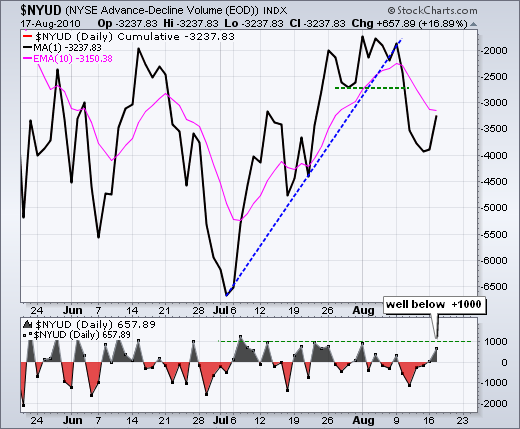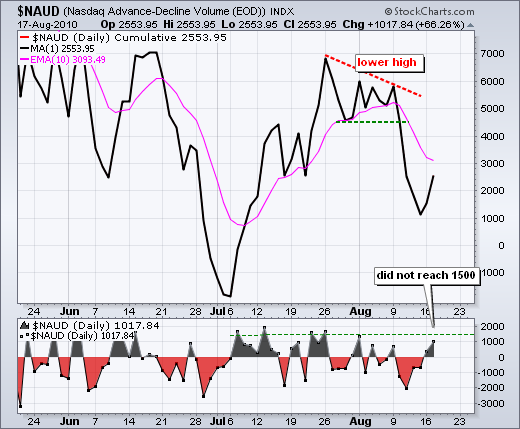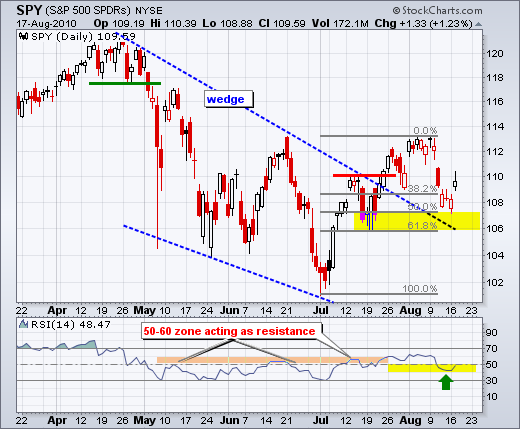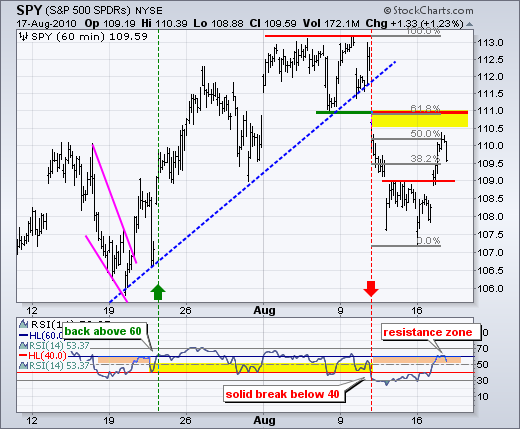Stocks bounced on Tuesday, but I was not impressed with the finish or with breadth. First, let's look at breadth. The charts below show the AD Volume Line and Net Advancing Volume for the NYSE and Nasdaq. NYSE Net Advancing Volume reached the +1000 level four times during the five week advance from early July to early August, but fell well short on yesterday's advance. Sustainable upswings often begin with a surge to +1000 in Net Advancing Volume. The NYSE AD Volume Line broke below support with last week's decline and the short-term trend is down for this key breadth indicator. The second chart shows the Nasdaq AD Volume Line forming a lower high in early August and breaking below support last week. Also notice that Net Advancing Volume did not reach +1500, a level that was breached four times in July. In short, breadth fell short.




And now for the weak close. SPY gapped above 109 on the open and surged to 110.39 intraday, but fell back and closed at 109.59. This close is below the mid point of the day's high-low range. A strong surge involves a gap AND a strong close. We got the gap yesterday, but not the strong close. The inability to finish strong undermines yesterday's advance.

On the 60-minute chart, SPY surged above the 50% retracement mark and the pulled back. The first resistance zone was set at 110.5-111 and SPY affirm this zone with the late pullback. Also notice that RSI met resistance around 60 yesterday. Technically, RSI edged above 60 early Tuesday, but I will allow a little wiggle room here. Remember, RSI briefly edged below 40 in late July and early August. With resistance reinforced, I will set key short-term resistance at 111. A break above this level would be bullish.

Key Economic Reports:
Wed - Aug 18 - 10:30 - Oil Inventories
Thu - Aug 19 - 08:30 - Jobless Claims
Thu - Aug 19 - 10:00 - Leading Indicators
Charts of Interest: Tuesday and Thursday.
This commentary and charts-of-interest are designed to stimulate thinking. This analysis is not a recommendation to buy, sell, hold or sell short any security (stock ETF or otherwise). We all need to think for ourselves when it comes to trading our own accounts. First, it is the only way to really learn. Second, we are the only ones responsible for our decisions. Think of these charts as food for further analysis. Before making a trade, it is important to have a plan. Plan the trade and trade the plan. Among other things, this includes setting a trigger level, a target area and a stop-loss level. It is also important to plan for three possible price movements: advance, decline or sideways. Have a plan for all three scenarios BEFORE making the trade. Consider possible holding times. And finally, look at overall market conditions and sector/industry performance.

About the author:
Arthur Hill, CMT, is the Chief Technical Strategist at TrendInvestorPro.com. Focusing predominantly on US equities and ETFs, his systematic approach of identifying trend, finding signals within the trend, and setting key price levels has made him an esteemed market technician. Arthur has written articles for numerous financial publications including Barrons and Stocks & Commodities Magazine. In addition to his Chartered Market Technician (CMT) designation, he holds an MBA from the Cass Business School at City University in London.
Learn More




